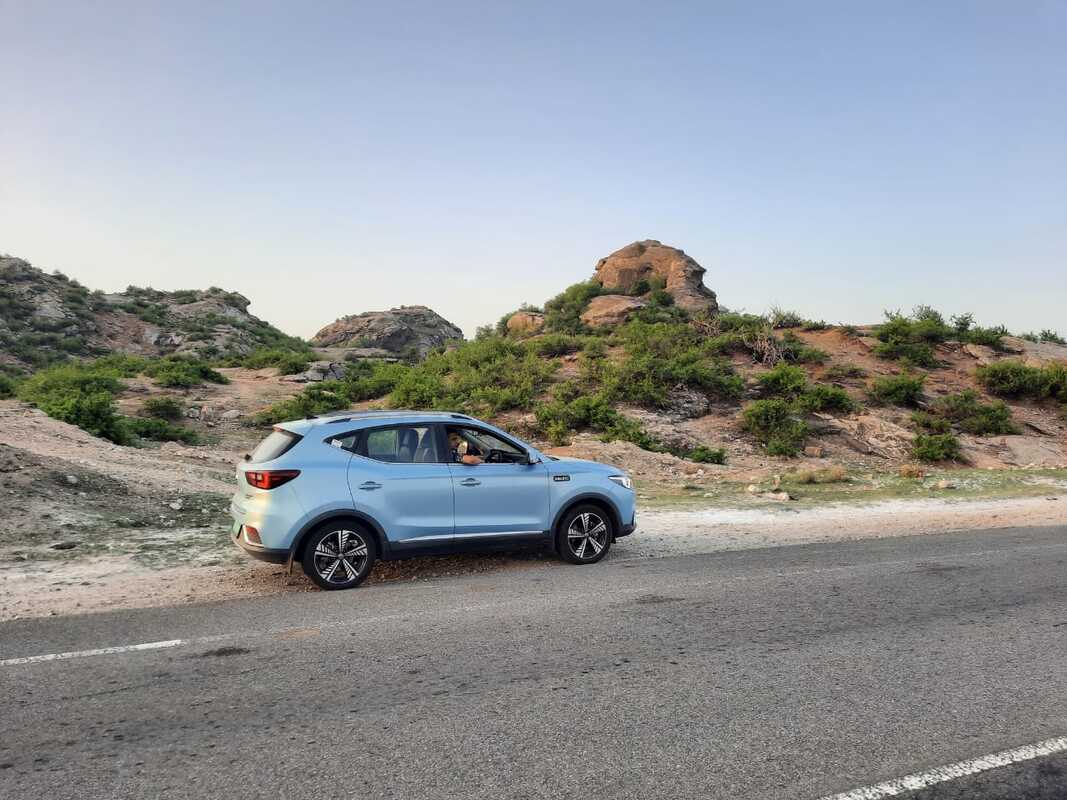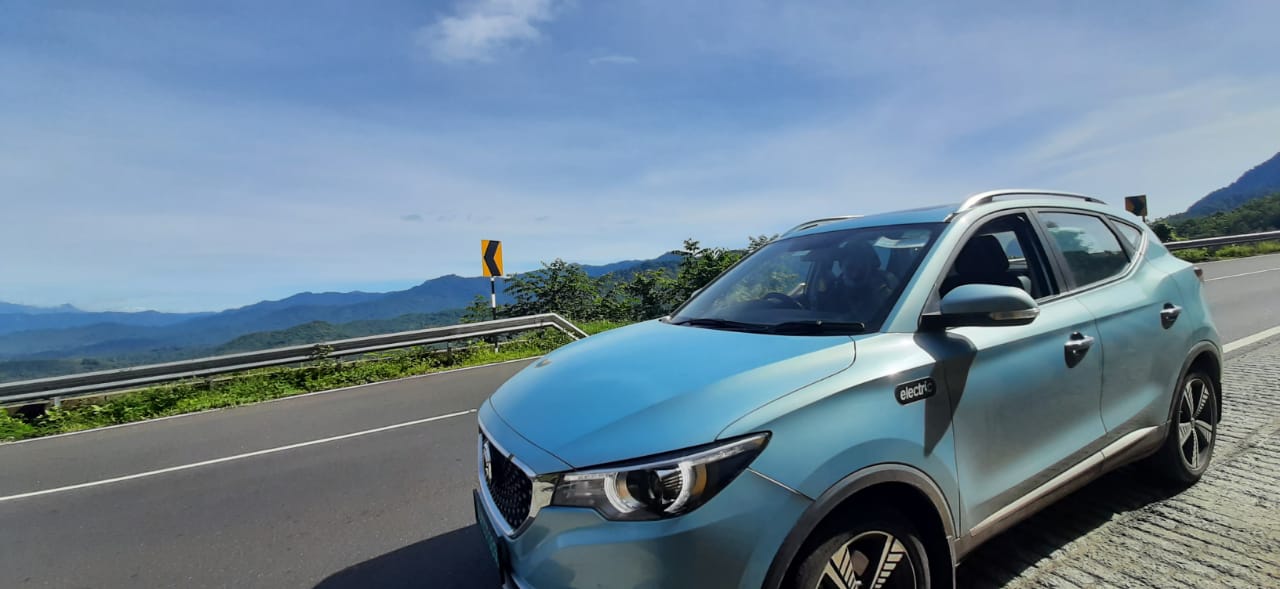Mr Vinod Pillai,
Owner of MG ZS EV
Photos credit Mrs Devika Pillai
We undertook a drive from Delhi to Kochi in an MG ZS EV. The confidence to do this was in part inspired by the fact that we had completed a round trip from Delhi to Pune earlier in Jan 21. So at least part of the route was well known to us. My effort in penning our experience is primarily to highlight the lessons learnt in driving an EV long distance over a period of 6 days, through 8 states through the lockdown imposed by the pandemic.
Interview with Mr Vinod Pillai, owner of MG ZS EV
The journey
The journey began early morning at 5 so that the Gurugram traffic could be overcome. The drive was scheduled with my first charging stop at Tata Motors Limited (TML) Shri Shyam Motors at a distance of 244 Km. The charging station uses a Tellus Power manufactured unit. The make of the charger is important and I shall summarise it towards the end. I reached the charging station with 31 % SOC and charged to full in about 2 hrs. The time taken was due to issues with the charger connectivity. More of that later. Thereafter we moved on to Beawar (200 Km) and terminated the journey for the day at Rani Bagh Resort. This was the first of the two places where we had to slow charge the car using a 15 A plug point. The charging was interrupted due to my 15 A plug burning. Fortunately, I was carrying a spare and used it to continue the charge.
Day 2 – Beawar to Baroda (582 Km).
The next day we commenced the journey at 5 30 AM. The car had an SOC of 88 %, It was sufficient to take me up to the MG Motors Udaipur showroom (215 Km) where the fast charger was located. IT was one on the most beautiful drives with the sunrise. We reached Udaipur uneventfully and connected up. Point to note here the charging unit was a Delta make. We spent time within the showroom and moved ahead towards Ahmedabad. The plan was to charge at TML Harsolia Brothers (240 Km) Gandhinagar. The point to note is that the MG ZS EV fully charged and running with AC on gives me a range of 286 Km. Driving in the afternoon in peak summer from Udaipur to Ahmedabad the AC was on full time. With a distance of 240 Km, we would be operating at the outer limit of endurance. As luck would have it, we reached the planned spot, but it was told to us that the charger was not operational due to load issues. We immediately decided to travel to the fall back plan of using the Fortum Charger at AM Motors Ahmedabad, which was 36 Km away. So it was a tense ride to the charger with the AC switched off in the sweltering heat. We completed the charge by 5 PM and decided to push on ahead to Baroda (127 Km) to charge up at TML ABC Autolink.
he next day was eventless. We headed to Tata Motors Laxmi Nagar Surat (171 Km). This place also used a Delta make charger. Our next charging stop was at MG Motors Thane (264 Km) where we
used the Fortum charger. The thing to note here is that though the distance was 264 Km, we still reached the destination with about 25 % charge owing to the regen we got coming down hill. We drove on to Pune (141 Km) and charged up at TML Bafna at Baner.
Day 4 – Pune to Hubli (426 Km)
his stretch is an interesting case study. On the road from Pune to Hubli there are six fast chargers between Pune and Kolhapur at an interval of approx. 100-150 Km. This gives us the confidence to drive fast as there was the reassurance of a charger at hand. The other thing to note is that three of these chargers were in the premises of restaurants. So, while the car charged, we
could enjoy a cup a tea. We topped up the charge on two occasions, once at Satara (Amrai Hotel) and another at Uran Islampur (Hotel Sai International). Since the next fast charger after Kolhapur was in Davengere. we perforce had to end the drive for the day at Hubli. The MG Motors at Hubli were gracious enough to provide us with a 15A slow charging point.
The next day we again charged up at Davengere TML Adishakti Motors (204 Km) (Delta make charger). Thereafter headed to Tumakuru (189 Km). At Tumakuru we encountered the Tellus Power make charger. It took its time to get connected. There were interruptions due to failure of the Tata Power EZ app etc. This resulted in the total period for charging taking upto three hours.
Nevertheless we pushed ahead to Mysore (152 Km) and charged up at the Zeon charger at the Mall of Mysore.
Day 6 – Mysore to Kochi (345 Km)
This was the most interesting stretch. As an EV owner our first instincts were to drive from Mysore to Coimbatore, charge and then move to Thrissur vis Palakkad for the next charge. The total distance in this case would have been 310 Km. However we could not take this route as both the Tata chargers and the Zeon chargers at Coimbatore were inaccessible due to the lockdown! So we were forced to consider the next option of using the Mysore – Ooty route to use the Zeon charger there (slow charge) and then head to Thrissur. The second option was to drive from Mysore-Gundulpete-Gudalur-Nilambur-Thrissur. We decided to take the second option. This was the most beautiful part of the journey through the Bandipur/Mudumalai forest. The icing on the cake was that the route from Mysore to Nilambur was all downhill. The regen ensured that we reached Nilambur with about 80% SOC! This gave us the confidence to head directly to Kochi where we ended the journey.
So, on a single charge we completed the last phase of 345 Km!
- Driving Style. We kept the AC on almost throughout except for the stretch in Ahmedabad. I drove on Cruise Control at speeds ranging between 70-90 Km/hr. I used to engage the Cruise Control as soon as I reached 30 Km/hr and then keep shifting the joystick up to gradually increase speed. This way the power requirement while accelerating never went above 20%. I always ended my runs with about 20 % SOC. This was essential to cater for any last-minute changes in route.
- Tata Charging Network. The tata power charging network is a working system. The entire journey could be planned only because of the visibility of the charging points on their app. Without them this journey was impossible.
- Tata Power Customer Support. I was in constant touch with the customer support personnel of Tata Power. These guys helped me a lot in confirming the operational status of the charger and also dealing with technical issues in connection and charging. They were accessible on phone and What’s App all the time even at late hours and on Sundays.
- Driving Comfort. Driving the MG ZS EV, in cruise control reduced driver fatigue. The seats were comfortable and the standard pains in the shoulder were significantly less. The AC was super effective, most time we had to reduce the cooling even in very hot driving conditions.
- Regen Works. The Regen was on setting 3 through out the journey. This way we got maximum regen when going downhill. The final days journey was a classic example of its efficiency.
- Driving Speeds. We drove at speeds of 70- 90 Km/hr. What was noticeable was that on plain roads, at speeds around 80 Km/hr, on cruise control, the power requirement of the car was consistently below 10%. It used to increase if we reduced the speed! It must be something to do with the maximum power being transferred at that rpm.
- Facilities at Charging Stops. The charging stops on long drives will invariably be for about 90 mins. This is a long period of time to be doing nothing. Most of the chargers were in the open with no protection from the elements. Imagine a situation where one is required to set up the charge in pouring rain, with no overhead protection the safety of the driver and the system is an issue that needs rectification by the companies.
Lessons Learnt – The Bad
- Charging Stations.We used charging stations of three companies namely, Tata Power, Fortum and Zeon. The latter two were easy to connect and commence charging. While the Tata Power chargers of Delta make were equally easy and hassle free it is the Tellus Power make chargers that presented issues. They had frequent issues of break in link, EV communication was iffy, and it required multiple rounds of reinsertion of charging gun to commence charging.
- Status of Charging Stations. The Tata power app displays the availability of the charging station with a green marker. Now on one occasion (at Gandhinagar) the app showed as the charger being available but actually it was having a power rating issue. On multiple occasions, the app would show the charger status with a grey marker due to link failure. One cannot charge till the link is restored for which we had to contact the customer care and they would give instructions on how to reboot the charger. This activity often required opening the charger rear door and accessing the breakers. This will be a big put off for most as they would not like to engage in such actions. There is a requirement to improve the reliability of the Tellus Power chargers in the Tata Power system.
- Fast Charging Infrastructure. We completed the journey in 5 and half days using an EV. But it was on a wing and a prayer. At every charging stop there was a period of anxiety on the operational status of the charger and also if we could complete the charge. While in cities there were possibilities of multiple options, in most places with just one charger the risk was high. In case it was non-operational, the options available are very limited. If long distance travel in EV has to become ubiquitous, then our highways need to have more fast-charging options. The highway between Pune and Kolhapur was one such stretch. It gave options in case one on them was faulty






